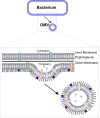Bacterial Outer Membrane Vesicles as Antibiotic Delivery Vehicles
- PMID: 34616401
- PMCID: PMC8488215
- DOI: 10.3389/fimmu.2021.733064
Bacterial Outer Membrane Vesicles as Antibiotic Delivery Vehicles
Abstract
Bacterial outer membrane vesicles (OMVs) are nanometer-scale, spherical vehicles released by Gram-negative bacteria into their surroundings throughout growth. These OMVs have been demonstrated to play key roles in pathogenesis by delivering certain biomolecules to host cells, including toxins and other virulence factors. In addition, this biomolecular delivery function enables OMVs to facilitate intra-bacterial communication processes, such as quorum sensing and horizontal gene transfer. The unique ability of OMVs to deliver large biomolecules across the complex Gram-negative cell envelope has inspired the use of OMVs as antibiotic delivery vehicles to overcome transport limitations. In this review, we describe the advantages, applications, and biotechnological challenges of using OMVs as antibiotic delivery vehicles, studying both natural and engineered antibiotic applications of OMVs. We argue that OMVs hold great promise as antibiotic delivery vehicles, an urgently needed application to combat the growing threat of antibiotic resistance.
Keywords: Gram-negative bacteria; antibiotic resistance; antibiotics; drug delivery; outer membrane vesicles.
Copyright © 2021 Collins and Brown.
Conflict of interest statement
The authors declare that the research was conducted in the absence of any commercial or financial relationships that could be construed as a potential conflict of interest.
Figures





Similar articles
-
Bacterial outer membrane vesicles as potential biological nanomaterials for antibacterial therapy.Acta Biomater. 2022 Mar 1;140:102-115. doi: 10.1016/j.actbio.2021.12.005. Epub 2021 Dec 9. Acta Biomater. 2022. PMID: 34896632 Review.
-
Gene Transfer Potential of Outer Membrane Vesicles of Gram-Negative Bacteria.Int J Mol Sci. 2021 Jun 1;22(11):5985. doi: 10.3390/ijms22115985. Int J Mol Sci. 2021. PMID: 34205995 Free PMC article. Review.
-
Bacterial outer membrane vesicles as a platform for biomedical applications: An update.J Control Release. 2020 Jul 10;323:253-268. doi: 10.1016/j.jconrel.2020.04.031. Epub 2020 Apr 22. J Control Release. 2020. PMID: 32333919 Review.
-
Gram-negative bacterial sRNAs encapsulated in OMVs: an emerging class of therapeutic targets in diseases.Front Cell Infect Microbiol. 2024 Jan 30;13:1305510. doi: 10.3389/fcimb.2023.1305510. eCollection 2023. Front Cell Infect Microbiol. 2024. PMID: 38983695 Free PMC article. Review.
-
Secretion and Delivery of Intestinal Pathogenic Escherichia coli Virulence Factors via Outer Membrane Vesicles.Front Cell Infect Microbiol. 2020 Mar 6;10:91. doi: 10.3389/fcimb.2020.00091. eCollection 2020. Front Cell Infect Microbiol. 2020. PMID: 32211344 Free PMC article. Review.
Cited by
-
Antimicrobial Resistance: What Lies Beneath This Complex Phenomenon?Diagnostics (Basel). 2024 Oct 18;14(20):2319. doi: 10.3390/diagnostics14202319. Diagnostics (Basel). 2024. PMID: 39451642 Free PMC article. Review.
-
Adaptations of Bacterial Extracellular Vesicles in Response to Antibiotic Pressure.Int J Mol Sci. 2025 May 23;26(11):5025. doi: 10.3390/ijms26115025. Int J Mol Sci. 2025. PMID: 40507835 Free PMC article. Review.
-
Research Progress on Bacterial Membrane Vesicles and Antibiotic Resistance.Int J Mol Sci. 2022 Sep 30;23(19):11553. doi: 10.3390/ijms231911553. Int J Mol Sci. 2022. PMID: 36232856 Free PMC article. Review.
-
Evaluation of the efficiency of various methods to load fluoroquinolones into Escherichia coli outer membrane vesicles as a novel antibiotic delivery platform.Biochem Eng J. 2024 Oct;210:109418. doi: 10.1016/j.bej.2024.109418. Epub 2024 Jul 2. Biochem Eng J. 2024. PMID: 39092080
-
Microbial extracellular vesicles contribute to antimicrobial resistance.PLoS Pathog. 2024 May 2;20(5):e1012143. doi: 10.1371/journal.ppat.1012143. eCollection 2024 May. PLoS Pathog. 2024. PMID: 38696356 Free PMC article. Review.
References
-
- U.S.Department of Health and Human Services Centers for Disease Control and Prevention . Antibiotic Resistance Threats in the United States. Atlanta, GA:U.S. Department of Health and Human Services, CDC; (2019). doi: 10.15620/cdc:82532 - DOI
Publication types
MeSH terms
Substances
LinkOut - more resources
Full Text Sources
Medical

